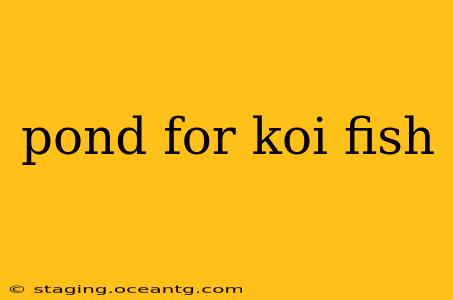Koi fish, with their vibrant colors and graceful movements, are a captivating addition to any garden. However, providing a thriving environment for these beautiful creatures requires careful planning and execution. This comprehensive guide will delve into the essential aspects of building and maintaining a koi pond, ensuring your fish live long, healthy, and happy lives.
What Size Pond Do I Need for Koi Fish?
The size of your pond is paramount. Koi are large fish and need ample space to grow and thrive. A general rule of thumb is to allow at least 100 gallons of water per fish, though larger is always better. Consider the mature size of your koi; they can grow to over 30 inches! A smaller pond will quickly become overcrowded, leading to stress, disease, and ultimately, death. Therefore, plan for future growth. Larger ponds are also more stable in terms of water temperature and quality.
What Depth Should My Koi Pond Be?
Depth is crucial for several reasons. Firstly, it helps regulate water temperature, preventing drastic fluctuations that can stress koi. A minimum depth of 4 feet is recommended, particularly in regions with harsh winters. This depth helps insulate the water and prevents freezing to the bottom. Secondly, deeper water provides refuge for your koi, particularly from predators like herons. Finally, the deeper the pond, the more stable the water quality.
How Much Filtration Do I Need for a Koi Pond?
Filtration is the backbone of a healthy koi pond. Koi produce a substantial amount of waste, and inadequate filtration will lead to a rapid deterioration of water quality, resulting in ammonia buildup and potential fish kills. You'll need a multi-stage filtration system, often including mechanical, biological, and UV filtration. Mechanical filtration removes solid waste, biological filtration processes ammonia into less harmful nitrates, and UV filtration sterilizes the water, killing harmful bacteria and algae. Oversizing your filtration system is always a good idea. Regular maintenance, including cleaning filter media, is crucial for optimal performance.
What Plants Are Good for a Koi Pond?
Aquatic plants play a vital role in a healthy koi pond ecosystem. They help oxygenate the water, provide shade for your koi, and absorb excess nutrients. Choose oxygenating plants like hornwort and water lilies, which also add aesthetic beauty. Avoid planting plants directly in the pond bottom, as koi will likely uproot them. Instead, consider using pots or baskets. Remember to choose plants suitable for your climate and pond conditions.
How Do I Prevent Algae Growth in My Koi Pond?
Algae blooms can quickly turn a pristine pond into a murky mess. Good filtration is your first line of defense, but other factors contribute. Excessive nutrients from fish waste or fertilizer runoff fuel algae growth. Regular partial water changes can help. Consider adding beneficial bacteria to your pond to help break down waste. In some cases, using an algaecide might be necessary but should be used cautiously and according to instructions.
What Are the Best Materials for a Koi Pond?
Choosing the right materials is essential for longevity and ease of maintenance. Pre-formed ponds are convenient but limited in size and shape. Custom-built ponds offer greater flexibility, often using liner materials such as EPDM rubber, which is durable and resistant to UV degradation. Concrete is another durable option, but construction is more complex and expensive. Consider your budget and aesthetic preferences when making your choice.
This guide provides a foundation for creating a thriving koi pond. Remember to research further based on your specific location, climate, and the number of koi you plan to keep. Regular maintenance, careful observation, and a proactive approach to water quality will ensure your koi enjoy a long and healthy life in their aquatic paradise.
